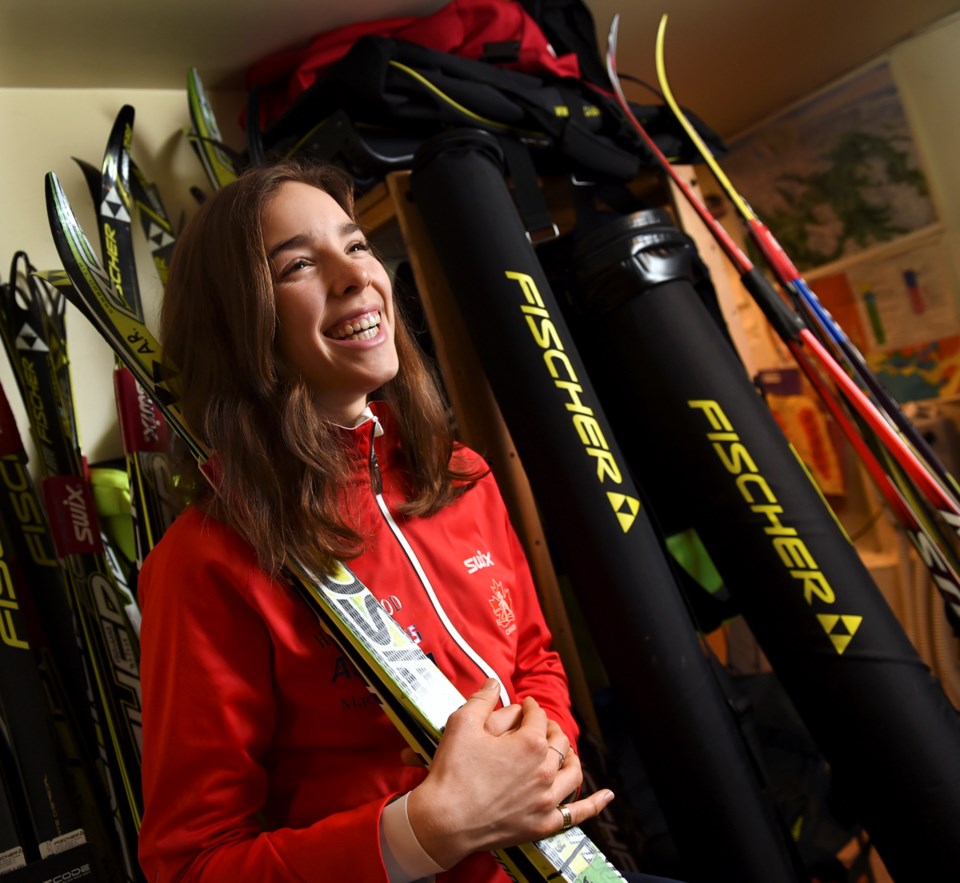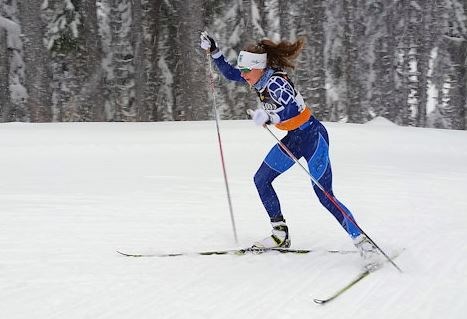When snow just wouldn’t fall on the North Shore Mountains last winter, cross-country skier Annika Richardson travelled the country and the globe to look for it elsewhere.
“I’m pretty sure I was away all of January every weekend, just trying to find snow,” she said this week.
She finished sixth in two different races at nationals, a result she “wasn’t super happy with” since the year before she nabbed two gold medals in the juvenile girls category at nationals.
“You have ups and downs in years,” she said. “I feel I didn’t get enough training hours on snow. I was reflecting that this year I was at a huge glacier, training 26 hours in 10 days, most on snow.”
This season brought snow to Cypress where she is a member of the Hollyburn Nordic Ski Club as well as memorable moments on the Canadian and international race circuit. The glacier was on the icefields at Mount Garibaldi. She also skied on fresh snow and in the Torsby Snow Tunnel in Sweden. And in Norway, she visited the Birkebeineren Ski Stadium, a cross-country ski venue for the Youth Olympic Games later this month in Lillehammer.
“You know, you could be skiing here at the Olympics,” Richardson said she remembered someone saying. “I thought it was a little far-fetched. But it turns out I’m going to be.”

Richardson will join Team Canada at the Lillehammer Youth Games Feb. 12 to 21. She knocked off her toughest rivals to win the right to represent her country.
Fighting spirit
The first race of her cross-country skiing career was also the only one she’s ever done at Cypress, where she trains. She was eight years old and came third in the Coast Cup event.
“After that I really wanted to stay on top and keep attaining the podium,” said the athlete who also competed in triathlon with the Exceleration club and is a lifeguard at the Hillcrest community centre.
Richardson said she got serious about cross-country skiing once she was racing a wider range of older athletes at the midget level. There was also one competitor who was faster, stronger and who she just couldn’t beat — until one day when she did.
“There were girls from the Okanagan I’d never raced before,” she said. “I made it through to the finals after the quarters and semis, then there were only four of us in the finals.”
Richardson came last, but it was both a success and a revelation. “That was the first time I realized I could be good and that I really wanted to compete with those girls. Growing up, I had this rival who was also one of my best friends. I realised eventually that she always beat me and one day I managed to beat her and it was almost like a mental block.”
Since Grade 8, she’s been on the podium of the BC Cup, a provincial circuit with a winner determined by aggregate points. She won gold twice and silver twice.
However, despite her personal victories, Richardson hasn’t failed to notice how the once-familiar faces of her competitors, teammates and training partners have slowly diminished. Many girls and young women stop playing sports. They may not get the support they need, or change friends and interests, or perhaps don’t see a future for themselves in athletics. Despite the life-long benefits, young women drift away from sport.
“There has been less and less competition as I’ve gotten older,” said Richardson, 17, who also competes in open categories against women of all ages.
“It’s kind of the sad thing about girls in sport. I find that a lot of them do chose something else… [saying,] ‘I’m not enjoying this as much an anymore and I don’t want to continue. It’s pretty upsetting because then there isn’t the depth of field. I find that guys deal with that less.”
She said men’s open rages have up to 70 competitors. The same category for women draw “20 or, at most, 40,” she said.
She said post-secondary schools that allow athletes to balance academics and athletics are a significant part of the solution. She is deciding between several college and university programs, saying her final choice will come down to a school that will accommodate her busy training and competition schedule.
Process makes perfect
The five-foot-nine cross-country running city champion finished ninth in the province at the B.C. high school finals in November at Jericho Beach Park. The cross-training maintains the fitness of an athlete who separates performance-based goals and process-based goals.
Reaching the podium at the Winter Olympic Games, for example, is a performance goal and one that is often outside an athlete’s complete control. Within their control is striving at practice, fine-tuning technique and marshalling mental focus — these are all part of a process that can lead to results in performance.
“Performance is something you achieve through your process,” said Richardson.
She didn’t set out to reach the Olympics, but her process — a gritty determination and ability to narrow her focus to the immediate moment — got her there in the end. And it all came down to one heck of a finish.
“I felt like I did everything right,” she said.
Throwing down
Team Canada based its selection on two December events, a combination of the five-kilometre and sprint races at the Canmore NorAm plus the 10 and five-km races at Sovereign Lake near Vernon.
After Canmore, Richardson was trailing her friend and biggest rival Hannah Mehain, of Vernon, in the points tally. Heading to Mehain’s home course, Richardson knew she’d have to win in order to be in contention for Team Canada.
“I was going into the weekend with pressure on me but I didn’t want to let that get to me,” she said. “On Sunday, in the 5K, I had the race of my life.”
Each racer starts at 30-second intervals, so they are in the dark regarding their time and overall position. Mehain jetted out of the gates and built a tremendous 30-second lead but by the time she reached the base of the final hill, 800 metres from the end, she was lagging and Richardson was closing in.
“It’s a tough course with a lot of uphill, a flat rolly section through the middle and then a downhill with an uphill to the end. I was skiing well and then I blew up in the middle section because I want really hard up the first hill,” said Richardson.
She hit the second-last hill, known as the Wall and feared her race was over.
“I yelled at myself,” she said. “I yelled out loud on the course, ‘You need to get yourself together and go.’”
Her coaches indicated she was trailing Mehain but didn’t say by how many seconds. Turns out the deficit was half a minute. “That is a lot with one kilometre to go,” said Richardson.
Then, something else came out of her. Not a shout, but vomit. “I threw up a little bit. I was tucking [down a hill] and I threw up,” she said.
The last hill was ahead of her, and Richardson pushed her body over the distance like a machine. “I killed myself to get to that finish line. I crossed, collapsed and kept throwing up,” she said.
She beat Mehain by seven seconds. Richardson started to cry. Mehain crashed over the finish line in third place, spent from the exertion of the punishing pace she set.
“All that emotional stress was repressed because of the pressure,” said Richarson. “That 5K was definitely one of my most memorable races.”
A race result based on a process that built to a performance that will lead her to the Youth Olympic Games.



